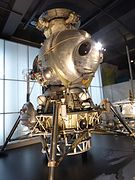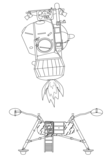LK (spacecraft)
 LK-3 test unit | |
| Manufacturer | OKB-586 |
|---|---|
| Designer | Mikhail Yangel |
| Country of origin | Soviet Union |
| Operator | Soviet space program |
| Applications | Crewedlunar landing |
| Specifications | |
| Spacecraft type | Lunar module |
| Launch mass | 5,560 to 6,525 kg |
| Crew capacity | 1 (2 on later variant) |
| Dimensions | 5.20 to 5.8 m high 4.50 m wide overall, landing gear deployed |
| Volume | 5 m3 |
| Power | N2O4/UDMH |
| Batteries | Equipped |
| Regime | Lunar orbit |
| Design life | 48 hours |
| Production | |
| Status | Canceled |
| Built | Several |
| Launched | 3(T2K) |
| Failed | 0 |
| Lost | 0 |
| Maiden launch | 24 Nov 1970 Kosmos 379(T2K) |
| Last launch | 12 Aug 1971 Kosmos 434(T2K) |
| Last retirement | |
| Blok E(Lunar descent/ascent) | |
| Powered by | 11D410 |
| Maximum thrust | 20 kN (4,500 lbf) |
| Specific impulse | 315 s (3.09 km/s) |
| Propellant | UDMH/N2O4[1] |
| Configuration | |
 LK components: 1) passive plate of the docking system, 2) attitude control nozzles, 3) orbital rendezvous window, 4) landing window (in a concave recess), 5) high-gain antennas, 6) solid-fuel "nesting" engines, 7) footpads, 8) omnidirectional antenna, 9) rendezvous radar, A) pressurized compartment, B) equipment compartment, C) hatch, D) batteries, E) engine and fuel tanks, G) ladder | |
TheLK(Russian:ЛК,fromRussian:Лунный корабль,romanized:Lunniy korabyl,lit. 'lunar craft';GRAU index:11F94) was alunar module(lunar landerdesigned for human spaceflight) developed in the 1960s as a part of severalSoviet crewed lunar programs.Its role was analogous to the AmericanApollo Lunar Module(LM). Three LK modules, of the T2K variant, were flown without crew inEarth orbit,but no LK ever reached the Moon. The development of theN1launch vehiclerequired for the lunar flight suffered setbacks (including several launch failures), and the firstMoon landingswere achieved by US astronauts onApollo 11.As a result, having lost theSpace Race,both the N1 and the LK programs were cancelled without any further development.
The N1-L3 flight plan[edit]
Sergei Korolev,the lead Soviet rocket engineer and spacecraft designer during the 1950s and 1960s, planned to adopt the samelunar orbit rendezvousconcept as seen in theApollo programme.The lunar expedition spacecraft L3 was to consist of aSoyuz 7K-L3Command Ship (a variant of theSoyuz) and an LK Lander. L3 would carry a two-man crew atop a single three-stage superheavyN-1booster. A fourth stage, the Blok G, would push the L3 (LOK+LK) toward the Moon, with theBlok Das a fifth stage.
Lunar orbit[edit]
TheBlok Dengine would also slow the L3 into lunar orbit. Following the coast to the Moon, one cosmonaut would spacewalk from theLOK (Soyuz 7K-L3)to the LK (Lunniy Korabl) lander and enter it. He would then separate the Blok D stage and the LK from the LOK before dropping toward the Moon using the Blok D engine. Once slowed from orbital velocity and placed on a trajectory to the vicinity of the landing site by the Blok D, the LK would separate from the Blok D and continue the descent and landing using itsBlok Estage on the LK for terminal deceleration and landing.
Lunar landing[edit]
An earlier uncrewed probe of theLuna programme,a Lunokhod would be used to select a suitable area, and then act as a beacon for the LK. A backup LK would then be launched to the landing site. The third step would see a crewed LK landing with a single cosmonaut.
Although the specifics on planned activity while on the lunar surface remain vague, the small size and limited payload capacity of the N-1/Soyuz LOK/LK compared to the Saturn/Apollo meant that not much in the way of scientific experiments could have been performed. Most likely, the cosmonaut would plant theSoviet flagon the Moon, collect soil samples, take photographs, and deploy a few small scientific packages.[citation needed]
Earth return[edit]
After a day on the lunar surface the LK's engine would fire again, using its landing leg structure as a launch pad. To save weight, the engine used for landing would also blast the LK back to lunar orbit for an automated docking with the LOK, using theSoyuz Kontaktdocking system. The cosmonaut would then spacewalk back to the LOK carrying the Moon rock samples, and the LK would then be cast off. After this, the LOK would fire its rocket for the return to Earth. The LK's docking port was a latticework of 96 hexagon-shaped holes arranged in an isometric grid, each as a potential docking port for the snare-shaped probe of the LOK to fit in without precise alignment of the two craft. Due to weight restrictions, the docking interface was designed to be as simple as possible, with a strictly mechanical interlock and no electrical or fluid connections. Docking and undocking were only possible a single time.[1]
Design[edit]
The LK spacecraft can be subdivided into the lunar landing aggregate ( "Lunnyi Posadochnyi Agregat", "LPA" ) and the lunar ascent vehicle, ( "Lunnyi Vzletnyi Apparat", "LVA'" ).[2]Propulsion, both for landing and lifting off the Moon was based on theBlok Epropulsion system. TheInformation Display System(spacecraft control panels and controls) version was calledLuch.
The four missions using an LK used theT2Kvariant, almost identical to the standard LK, but without landing gear.
Systems[edit]
The spacecraft included the following systems:[2]
- Pressurized cosmonaut compartment;
- Flight control avionics;
- Life-support system;
- Attitude control systems;
- Lunar landing device, or LPU, with four landing legs;
- Power supply system, consisting of chemical batteries attached to LPU;
Instruments[edit]
The spacecraft included the following instruments:[2]
- Planetalanding radar
- pressurized avionics container
- two communication antennas
- three batteries
- four containers with water for a vaporization unit
- robotic arm and drill
Testing[edit]
The LK variantT2Kwas tested uncrewed in Earth orbit over three missions between 1970 and 1971.[3] All three LKs were launched with theSoyuz-Lrocket. The first flight imitated the planned working cycle of theBlok Estage. The second and third flights were intended to test the LK's behavior under several flight anomalies. All flights went well, and the LK was considered ready for crewed flight.[1]
| Mission | Launch date | Orbital decay | Orbit | Duration (in orbit) |
Outcome |
|---|---|---|---|---|---|
| Kosmos 379 (T2K No.1) |
24 November 1970 11:00 UTC |
21 September 1983 | 198 km x 253 km | 12 years and 301 days | Success[4] |
| Kosmos 398 (T2K No.2) |
26 February 1971 12:14 UTC |
10 December 1995 | 196 km x 276 km | 24 years and 287 days | Success[5] |
| Kosmos 434 (T2K No.3) |
12 August 1971 09:30 UTC |
23 August 1981 | 187 km x 11,777 km | 10 years and 178 days | Success[6] |
Cancellation[edit]
The success of theApollo programin putting American astronauts on theMoonin 1969 meant that the United States won theMoon race,although plans were being drawn right up until the early 1970s. Four N1 launches were attempted including two later with dummy LK but all were failures, despite engineering improvements after each failure. The second launch attempt on July 3, 1969, just 13 days prior to the launch ofApollo 11,was a catastrophic failure which destroyed both the rocket and the launch complex. Subsequently, the complete L3 lunar expedition complex with regular LK andSoyuz 7K-LOKmodule-spacecraft for Moon flyby and landing by full uncrewed mission of future crewed scenario was prepared for fifth launch of modified N1 rocket in August 1974. TheN1-L3program was cancelled in May 1974 and the Soviets decided to concentrate on the development ofspace stations,achieving several firsts in the process.[7]
In 2017, there was an anonymous claim that Chinese officials asked the Ukrainians to rebuild the very original LK's propulsion module using modern materials like new computer technology replacing obsolete electronics in the module's flight control system. According to the agreement, Ukrainians will transfer China the newly produced set of design documentation for the propulsion module, but the hardware itself will remain in Ukraine. In the future, Ukrainians might assist the Chinese in organizing the production of the technology in China, sources said.[8]
LK compared to the Apollo Lunar Module[edit]
Because the payload capacity of the N1 rocket was only 95 tons toLEO,versus theSaturn V's 140 tons to LEO, the LK was created to be less bulky than theApollo Lunar Module(LM):
- It had a different landing profile
- It was lighter at only one-third the mass of the LM
- Initially the LK was to have carried a single cosmonaut. A later variant would have a two-man crew; the LM carried two
- It had no docking tunnel like the LM's; the cosmonaut wouldspace walkfrom theLOK (Soyuz 7K-L3)to the LK and back.
- To leave lunar orbit and begin descent, the LK used the same braking stage, the Blok D, which put the LK-Soyuz stack into lunar orbit; the LM used its landing stage engine (later Apollo missions also used the SPS engine to help deorbit the LM).
- The final deceleration, from a velocity of 100 m/s at an altitude of 4 km above the lunar surface, was done with aBlok Estage, capable of multiple restarts. This allowed the Blok E to also serve as the ascent stage to return the LK to lunar orbit; the LM's landing stage had a dedicated engine for landing.
- For better performance, LK Blok E engines usedturbopumpsto provide them with fuel components. Solid charges were used for quick activation of the pumps that limited the number of ignitions.
- After landing the LK landing gear structure was designed to serve as a mini-launch complex for the upper stage's lift-off; the Apollo LM used its descent stage in the same fashion.
- The LK Blok E had both primary and reserve engines allowing for reassurance of ascent; the Apollo LM lifted off with a single ascent engine, and had no backup or reserve but was designed for simplicity and reliability allowing for optimal assurance of ascent. A failure of the LM ascent engine would guarantee a critical mission failure.[1]
Current location[edit]
There are five remaining LK in various stages of completion. They are at:[1][9][10]
- Moscow Aviation Institute(temporarily displayed atDisneyland Paris)[10]
- Orevo Research and Educational Facility ofBauman UniversityinDmitrov
- RKK Energia plantatKorolev
- Tambov air base
- A.F. Mozhaysky Military-Space AcademyinSt Petersburg
- London Science Museum“Cosmonauts” exhibition (2016)[9]
-
A LK lander at theRKK Energia plant,2016
-
LK-3 engineering test unit,Science Museum,2016
See also[edit]
- Zond program
- Apollo 18(film)
- Single-person spacecraft
- List of crewed lunar lander designs
- Apollo Lunar Module
- Lanyuelander
References[edit]
- ^abcde Mark Wade."LK".astronautix.Encyclopedia Astronautica.Retrieved24 October2023.
- ^abc Anatoly Zak."LK lunar module for the L3 project".RussianSpaceWeb.Retrieved15 December2013.
- ^ Gunter D. Krebs."LK (L3, T2K) - Gunter's Space Page".space.skyrocket.de.Retrieved30 May2024.
- ^ "Cosmos 379".nssdc.gsfc.nasa.gov.NASA.Retrieved21 August2019.
- ^ "Cosmos 398".nssdc.gsfc.nasa.gov.NASA.Retrieved30 May2024.
- ^ "Cosmos 434".nssdc.gsfc.nasa.gov.NASA.Retrieved30 May2024.
- ^ Mark Franchetti (3 July 2005)."Russia plans first men on Mars".timesonline.co.uk.London:The Times.Archivedfrom the original on 24 February 2024.Retrieved5 February2008.
- ^ Anatoly Zak (19 June 2017)."Long Abandoned Soviet Tech Might Help China Land on the Moon".popularmechanics.Popular Mechanics.Archivedfrom the original on 17 January 2021.Retrieved18 September2019.
- ^ab Nick Stevens (20 February 2016)."Soviet LK Moon lander".Nick Stevens Graphics.Archivedfrom the original on 1 October 2023.Retrieved24 October2023.
- ^ab "Soviet Manned Lunar Program Gallery".ninfinger.org.Archivedfrom the original on 8 July 2021.Retrieved24 October2023.








